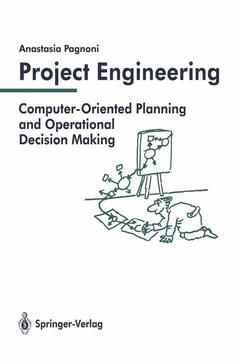Description
Project Engineering, Softcover reprint of the original 1st ed. 1990
Computer-Oriented Planning and Operational Decision Making
Language: French
Publication date: 01-2012
239 p. · 15.5x23.5 cm · Paperback
239 p. · 15.5x23.5 cm · Paperback
Description
/li>Contents
/li>
Manufacturing processes, scientific experiments, research programs, tax collection systems, are all endeavors once born as projects. Project engineering is the application of science to the development and analysis of project plans, and to the supervision of their realization. This book is a unified treatise on the technology of project planning and execution. It provides a systematic understanding of the different methodological approaches to the development and supervision of project plans. Readers are given a technical introduction to the main methodologies, such as graphs, activity networks, CPM, PERT, GERT, and Petri nets, and given guidance as to when and why to apply one technique rather than another. The book deliberately emphasizes those techniques which are particularly suitable to exploiting the power of computation, and therefore supplies a solid platform for applying computer tools to the analysis and control of projects. The book also introduces ODM, a methodology based on the theory of fuzzy sets for supporting plan execution supervisors in making operational choices. The book is self-contained. It is designed to serve professionals and students in the fields of systems engineering, computer aided planning, and decision support systems.
1. Survey of Methodologies.- 2. Planning with Temporal Constraints.- 2.1 Graphs, Weighted Graphs, Bipartite Graphs.- Subgraphs.- Digraphs.- Walks in Graphs and Digraphs.- Connected Graphs, Weakly and Strongly Connected Digraphs.- Trees.- Graph Matrices.- Digraph Representation of Plans.- 2.2 Activity Networks.- Planning with Activity Networks.- Activity Network Unfoldings.- 3. Disciplined Planning.- 3.1 Top-Down Development of Plans.- 3.2 Disciplined Planning Syntax.- 4. Planning under Precedence/Duration Constraints: Networking Techniques.- 4.1 No Choices, No Cycles, Known Durations: CPM.- Execution Control: Event Time Bounds.- Critical Paths.- Event Realization Slacks.- Activity Time Bounds.- 4.2 No Choices, No Cycles, Known Direct Costs: Cost-CPM.- Updating of Time Schedule and Cost Plan.- Cost Optimization.- Analytical Cost Optimization Algorithm.- A Heuristic Speeding Up Algorithm.- Operational Considerations.- 4.3 No Choices, No Cycles, Beta-Distributed Durations: PERT.- Probability Distribution of Activity Durations.- The Beta Distribution.- The Critical Path Question.- Investigation of Project Completion Time.- Warnings about Improper Use of PERT.- PERT Cost Planning and Optimization.- Operational Considerations.- 4.4 Choices, Cycles, Random Durations: GERT.- Event Realization “Logics”.- Network Structure.- Probability Distribution of Activity Durations.- STEOR Networks and Markov Renewal Processes.- The MRP Method.- Simulation of GERT Networks.- 5. Clock-Independent Planning: Petri Nets.- 5.1 Causal Interconnection of State and Transition Elements: Nets.- Enabling, Steps, Reachability.- Pure Nets, Simple Nets.- S-Graph, T-Graph, Free Choice Net.- Subnets, S-Vectors, T-Vectors.- 5.2 Causal Interconnection of Conditions and Events: CE Nets.- About Petri NetPlans.- 5.3 Causal Interconnection of Resources and Operations: FT Nets.- Incidence Matrix.- Reachability Graph.- Liveness, Stop States and Home States.- 5.4 Conservation of Resource Counts and Reproduction of States: S- and T-Invariants.- Calculation of Invariants.- Project Analysis by Means of Invariants.- 5.5 Representing Operations with Variable Resources Compactly: an Outline of PrT Nets.- 6. Net Plan Executions.- 6.1 Representing Net Plan Executions.- Execution Nets.- 6.2 Figuring Out Execution Alternatives: Control Nets.- 7. Choosing a Course of Action: Operational Decision Making.- 7.1 Execution Alternatives.- 7.2 The Formal Representation of Vagueness: Fuzzy Sets.- 7.3 Fuzzy Attributes.- Attributes over Operations.- Attributes over Alternatives.- Attributes over Executions.- 7.4 Preference Degree of Executions. Optimal Executions.- Weighted Attributes.- 7.5 Clustering Executions into Preference Classes: Fuzzy Outranking.- Fuzzy Outranking Relation.- Classification of Executions.- Singling out Best Executions: Dichotomy.- Partitioning Executions into Preference Classes: Polychotomy.- References.- Further Reading.
© 2024 LAVOISIER S.A.S.




